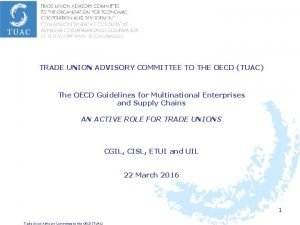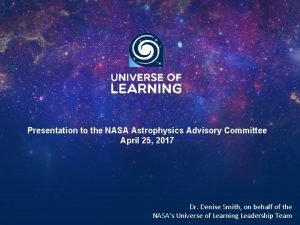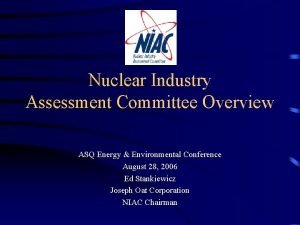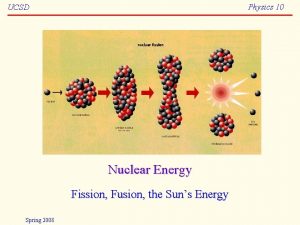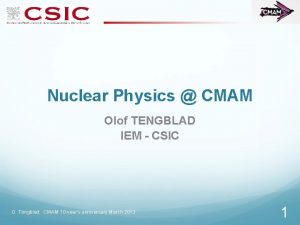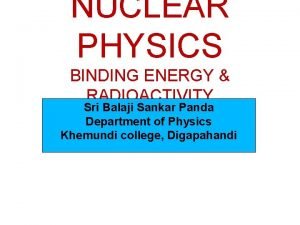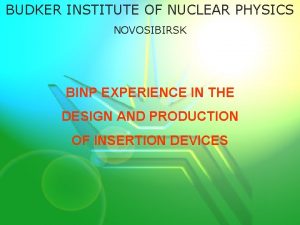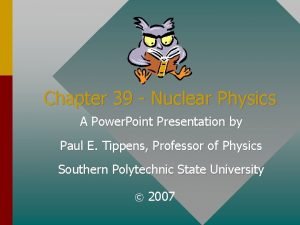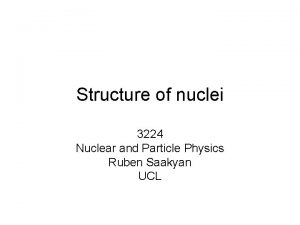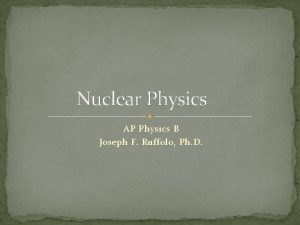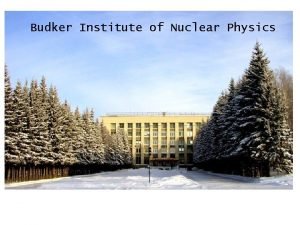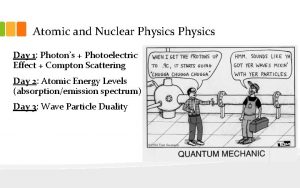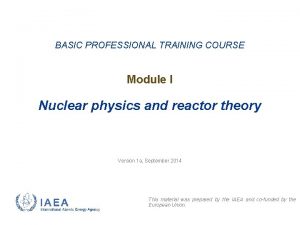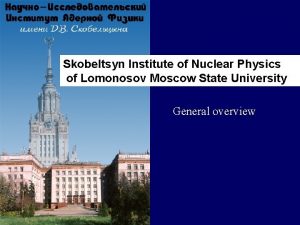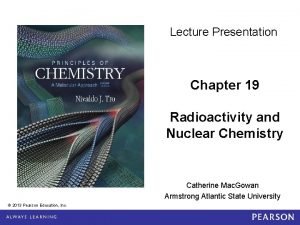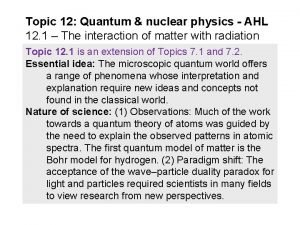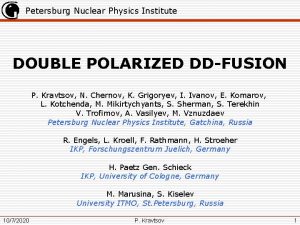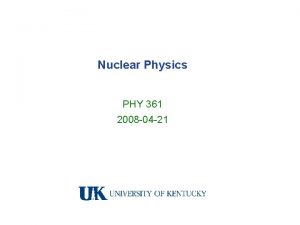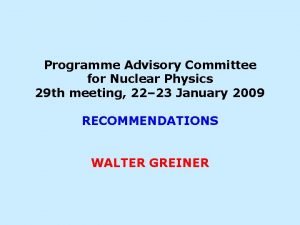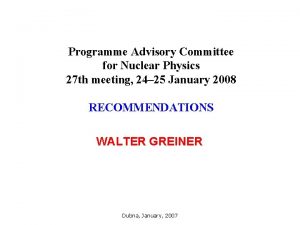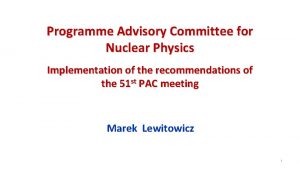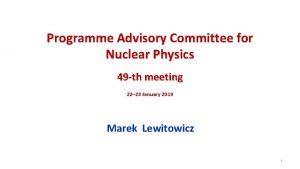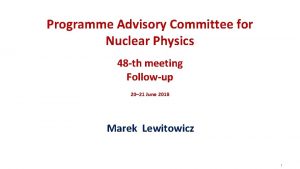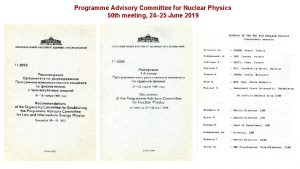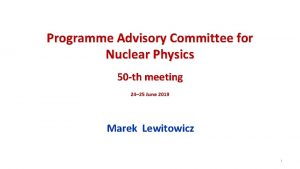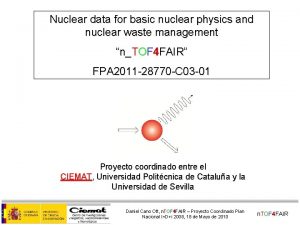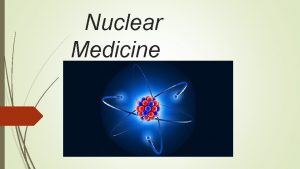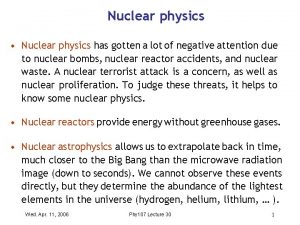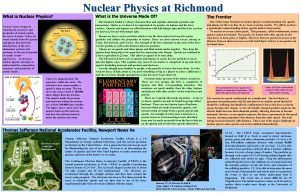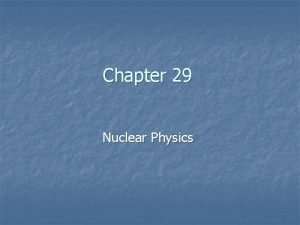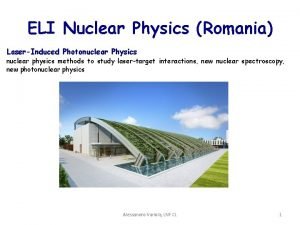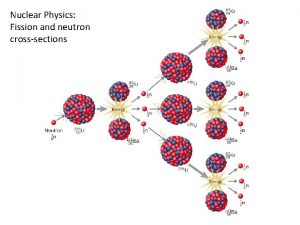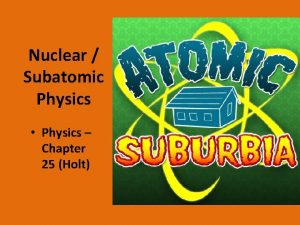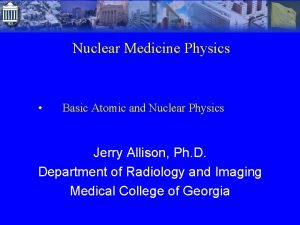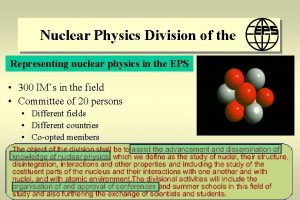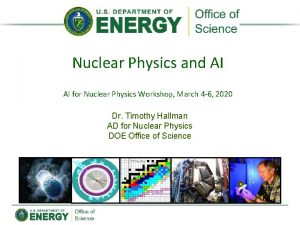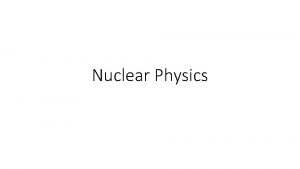Programme Advisory Committee for Nuclear Physics 51 st































- Slides: 31

Programme Advisory Committee for Nuclear Physics 51 st meeting 30– 31 January 2020 Marek Lewitowicz 1

Programme Advisory Committee for Nuclear Physics, 51 st meeting, 30– 31 January 2020 4. Research activities under theme “Investigations of Neutron Nuclear Interactions and Properties E. Lychagin of the Neutron”: status and prospects 5. Letter of intent to open a new project: “Modernization of the EG-5 accelerator and development A. Doroshkevich of its experimental infrastructure” 6. Proposal for opening a new project: “BECQUEREL” 7. Status of the Factory of superheavy elements 8. Prospects for the study of multinucleon transfer reactions P. Zarubin V. Semin, V. Utyonkov A. Yeremin 9. Poster presentations by young scientists 10. Scientific reports: 10. 1. “Fusion reactions in nuclear astrophysics” V. Sargsyan 10. 2. “Prompt neutron investigation in nuclear fission induced by resonance neutrons” S. Zeynalov 2

Research activities under theme “Investigations of Neutron Nuclear Interactions and Properties of the Neutron”: status and prospects 50 th PAC for NP recommendations for this theme Egor Lychagin • In the future the PAC expects more details on the programme of nuclear data measurements, in particular the objectives, the priorities and the complementarity with the worldwide programmes. • The FLNP Directorate is advised to focus on the modernization of experimental halls and pavilions. • The PAC recommends that special attention be given to the beam delivery systems to increase neutron fluxes at the experiment places. The PAC expects a detailed report on this topic to be presented at the next meeting. 3

Research activities under theme “Investigations of Neutron Nuclear Interactions and Properties of the Neutron”: status and prospects The leader of theme was appointed Egor Lychagin instead of Valery Shvetsov The very broad research program in the framework of theme includes: • research of quantum-mechanical phenomena with ultracold and cold neutrons; • Including Development of the advanced Very Cold Neutron Source • study of properties of the neutron; • Including Investigation of possibility of the neutron lifetime measurement at IBR-2 beam • study of nuclear reactions induced by neutrons; • Including program at TANGRA facility • Including investigations of various fission parameters and characteristics of Prompt Fission Neutron (PFN) emission • applied research using nuclear physics methods. • Including development of the Neutron Activation Analysis (NAA) and Neutron Resonance Capture Analysis (NRCA) Egor Lychagin 4

Research activities under theme “Investigations of Neutron Nuclear Interactions and Properties of the Neutron”: status and prospects Development of the advanced Very Cold Neutron Source Collaboration in the framework of CREMLINplus WP 3 T 3. 1 between: ILL (Grenoble, France), NRC KI-PNPI (Gatchina Russia), JINR (Dubna, Russia), PTI (St-Petersburg, Russia), UCA (Clermont-Ferrand, France), UNIMIB (Milano, Italy), ESS (Lund, Sweden) NCSU (Raleigh, NC, USA) During the last year, a lot of simulation and experimental work (NAA, SANS, XRD, PGA etc. ) was done to define optimal parameters of the powder and its production. In 48 months (starting from February 2020) the prototype of the VCN source should be developed and tested experimentally. 5

Measurements of yields and gamma rays' angular correlations in reactions with 14. 1 Me. V neutrons (TAgged Neutrons & Gamma-Rays -TANGRA project). Modernization of the TANGRA facility using an HPG detector are planned in 2020 -2022 : • further measurements of yields and angular correlations of gamma rays • measurement of the reactions (n, 2 n) and (n, f) • theoretical analysis of experimental data Measured nuclei Closest plans 6

Research activities under theme “Investigations of Neutron Nuclear Interactions and Properties of the Neutron”: status and prospects Investigations of various fission parameters and characteristics of Prompt Fission Neutron (PFN) emission. • A double ionization chamber was designed to measure the kinetic energies, masses, and the orientation of fission axis in the 3 D space for the correlated fission fragments. • The accuracy of direction cosines definition is better than 0. 05 • 32 PFN detectors were placed close to the axis of the ionization chamber to guarantee the maximum PFN detection efficiency ~0. 8π. The set-up was totally assembled, the work place at the beam line № 2 of IREN was prepared. 7

Research activities under theme “Investigations of Neutron Nuclear Interactions and Properties of the Neutron”: status and prospects Applied Research Experimental methods and setups • NAA, XRF (REGATA, REGATA-2) • Neutron resonance spectroscopy (at IREN) • Experiments at Van-der-Graaf EG-5 (modernization of the accelerator) International program "Heavy metal atmospheric deposition in Europe” Mo, W and Sb Further plans for Neutron Activation Analysis (NAA) • Including the REGATA facility in the FLNP User Programme; • Improvement of the NAA at the REGATA facility at IBR-2; • Development and construction of the low-background γ-ray spectrometer and the α spectrometer; • Participation in the 2020/2021 European moss survey; • Research in the field of environmental studies, geology, material science, medicine, nanotoxicology, etc. In 2019 in the framework of the “Mussel watch” project of JINR-SA mussels were collected at the six stations along the South African coast, The obtained data showed that the most polluted place is the area near Capetown. Moscow 8

Research activities under theme “Investigations of Neutron Nuclear Interactions and Properties of the Neutron”: status and prospects Neutron Resonance Capture Analysis (NRCA) The main advantages of the Neutron Resonance Analysis: • Nondestructive, • Sensitivity to isotopic element content, • Fundamental opportunity to study samples of any shape and size, • Very limited induced activity. 10 coins from the largest treasure of the Bosporus straits of the 3 rd-4 th centuries. A. D. № 1 Element Cu 2 Ag Measured weight 73. 033 g Mass, g 63. 4± 3. 2 8. 42± 0. 27 71. 8 3. 2 g In 2020, it is planned to conduct research at the IREN facility on archaeological samples obtained from the Institute of Archeology of the Russian Academy of Sciences. 1. HPGe gamma detector 2. B 4 C cover 3. Lead shield covered with Cd 4. Li. F window 5. Sample cross icon horseshoe-shaped fragment metal object of the bell

PAC for NP recommendations for theme “Investigations of Neutron Nuclear Interactions and Properties of the Neutron” • The PAC recommends that priorities of this theme be better focused. • Special attention should be paid to the development of key technologies for the new neutron source. • The PAC appreciates the development of activities related to Intense REsonance Neutron Source (IREN). • The PAC encourages an active use of the extracted beams for both basic and applied research in order to make more efficient use of the facilities operating time.

Letter of intent to open a new project: “Modernization of the EG-5 accelerator and development of its experimental infrastructure” New project Technical task: Restoring the technical parameters of the EG-5 accelerator: • energy up to 4. 1 Me. V (2, 9 Me. V today) • current above 50 m. A (100 n. A today) Ways to solve: • Tube replacement; • Modernization of infrastructure; • Young staff training. Alexander Doroshkevich Plans Development of the experimental infrastructure 1. New spectrometers. 2. Microbeam Project. 3. Use of multibeam configuration The estimated 3 -years project cost is 1, 5 M$ 11

PAC for NP recommendations for the letter of intent to open a new project: “Modernization of the EG-5 accelerator and development of its experimental infrastructure” • The PAC supports the presentation of a full proposal within theme “Investigations of Neutron Nuclear Interactions and Properties of the Neutron”. • The project should define expected accelerator specifications in accordance with the priorities of the scientific programme. • The PAC recommends comparing carefully the two options: modernization of the present EG-5 accelerator or purchase of a new accelerator taking into account the risk associated with the proposed upgrade. • The full project should include detailed information about the schedule, human and financial resources as well as a risk analysis. 12

Proposal for opening a new project: “BECQUEREL” Pavel Zarubin Studies of nuclear fragmentation using nuclear emulsions have a very long history. Nevertheless this method still keeps promising opportunities, in particular due to the high resolution in determination of emission angles of relativistic fragments. The project is devoted to experiments with various accelerators, apart from studies of multifragmentation processes, authors plan to search for unstable states in nuclei. The PAC recommends that the VBLHEP Directorate provide financial support for renovation of the equipment used in the BECQUEREL experiment in 2021. The proposal should be presented at the PAC meeting in January 2021. 13

Status of the Factory of superheavy elements: DC-280 cyclotron Vasiliy Semin Accomplished tasks: • Test of accelerator systems with high intensity • Testing of cyclotron systems during longtime operation • Investigation of stability of accelerated beams • Debugging of high voltage elements • Staffing of the DC-280 work group 14

Status of the Factory of superheavy elements: DC-280 cyclotron Reached today: • 40 Ar beam intensity 10 pm. A; • 48 Ca beam Intensity 5 pm. A; • 50% efficiency from axial injection to transport channel; • 90% efficiency through transport channel to the separator; • 5% beam current stability; Ongoing tasks: • HF amplifier power supply stability; • Commissioning of Flat-Top System; • Curing electrical breakdowns of some HV elements; • Improvement of the overall efficiency 15

Main parameters of the DC-280 parameters Ion source design Reached for today DECRIS-PM - 14 GHz on the HV platform (Umax=60 k. V ) Up to 80 ke. V/q 38, 04 – 72, 89 k. V 4÷ 7. 5 4, 44 (40 Ar+7) – 6, 86 (48 Ca+7) 4÷ 8 Me. V/n 4, 01 – 7 Me. V/n 4 -136 12 (12 C+2) – 84 (84 Kr+14) Intensity (A~50) >10 pµA 10, 43 pµA (40 Ar+7), 5, 2 pµA (48 Ca+7) Magnetic field level 0. 6÷ 1. 3 T 0. 8÷ 1. 23 T Injecting beam potential A/Z Energy Ion (from DECRIS-PM) K factor Dee voltage 280 2 x 130 k. V Power of RF generator Flat-top dee voltage 2 x 30 k. W 2 x 13 k. V Power of Flat-top generator Emittance Accelerator effectivity 2 x 130 k. V --2 x 2 k. W less than 30 π mm·mrad >50% 51, 9 % (48 Ca+10 5 Me. V/n 5 pm. A)

Status of the separator DGFRS-2: results of test experiments The installation and commissioning of the new gas-filled separator (GFS-2) was completed. Test reactions: nat. Yb+40 Ar 207 -212 Ra, 170 Er+48 Ca 214, 215 Ra, nat. Yb, 174 Yb+48 Ca 216, 217 Th, 206 Pb+48 Ca 252 No Vladimir Utyonkov Adjustment of optical elements Qv, Dh, Qv, D Transmission Image size on detector Dispersion Background Optimal gas pressure Systematics of charge states Target stability vs. beam intensity Yield vs. target thickness Test of digital and analog data acquisition systems The experiments showed excellent background event suppression in the focal plane of the separator 17

Status of the separator DGFRS-2: results of test experiments Test reactions: Cross sections ~108 -9 pb nat. Yb (0. 21, 0. 43, 0. 54, 0. 64 mg/cm 2)+40 Ar 207 -212 Ra nat. Yb (0. 21, 0. 43, 0. 54, 0. 64 mg/cm 2)+48 Ca 216, 217 Th 174 Yb (0. 35 mg/cm 2) +48 Ca 216, 217 Th 170 Er (0. 54 mg/cm 2)+48 Ca 214, 215 Ra 206 Pb (0. 43 mg/cm 2) +48 Ca 252 No

Future experiment at SHE Factory 243 Am+48 Ca → 291 Mc* reaction Cross section 10 pb s=8. 5 pb, ht=0. 5 mg/cm 2, coll=0. 6, Ibeam=5 pm. A N 17/day Excitation function for the 2 n-evaporation channel (289 Mc) - Observation of a decay of 281 Rg Excitation function for the 3 n-evaporation channel (288 Mc) 5 n-evaporation channel: new isotope 286 Mc

PAC for NP recommendations related to “Status of the Factory of superheavy elements: DC-280 cyclotron” • The PAC congratulates the Flerov Laboratory of Nuclear Reactions for the excellent work in this highly demanding field of SHE research. • The intensities achieved at DC-280 are already among the highest in the world, and the results are extremely encouraging for the continuation of this research programme. • The PAC recommends that FLNR continue the efforts of completing the test experiments and starting the implementation of the experimental programme at the SHE Factory. 20

Prospects for the study of multinucleon transfer reactions (MNT) Regions of interests in MNT reactions 1 1 Study of neutron deficient isotopes in the region 82 < Z < 100 3 Alexander Yeremin 2 2 Study of isotopes in the region N = 126, r – process in astrophysical nucleosynthesis 3 Study of neutron rich isotopes in the region Z > 100 21

Prospects for the study of multinucleon transfer reactions (MNT) Feasibility studies at SHELS Isotopic distributions of MNT products measured in collisions of Ti + Pb at SHELS → sensitivity: 10 pb/sr in 5 hours of irradiation Next experiment : April 2020, 48 Ca + 243 Am, study of MNT products, 1 week

Prospects for the study of multinucleon transfer reactions (MNT) Future Plans at FLNR • Are MNT reactions suitable for the production of (super)heavy nuclei? • Z > 92, N ≈ 126 → MNT might be favourable for n-deficient transuranium isotopes • n-rich SHE → study of new isotopes up to Z ~ 108 seems to be feasible Future development of dedicated experimental set up analysis of MNT products under different angles. New project of set-up Separator for Trans. Actinide Research (STAR). STAR

PAC for NP recommendations for “Prospects for the study of multinucleon transfer reactions (MNT)” The PAC remarks that, along with the study of new isotopes, the exploration of MNT-reaction mechanism is of great importance, and strongly supports the development of a specialized set-up dedicated to a comprehensive study of such mechanism. Investigations of MNT reactions will highly benefit from the upgrade of the U-400 cyclotron complex, where it is planned to produce also an uranium beam of sufficient intensity. • The PAC recommends presenting as soon as possible a detailed project of a new dedicated set-up aimed at measuring features of the MNT reactions and their products (for instance, mass, energy, angular distributions, and possibly charge). • The PAC also recommends substantiating this project with an in-depth theoretical study aimed at clarifying the correlation of the entrance channel of the reaction with the above mentioned features of the MNT reactions and products.

Scientific reports The PAC heard the report “Fusion reactions in nuclear astrophysics” • Using quantum diffusion approach, the S-factors for fusion reactions like 12 C+12 С –– important for stellar evolution –– are calculated, extrapolated to low energy and compared with experimental data. Shakir Zeynalov Vazgen Sargsyan The PAC heard with interest the report “Investigation of prompt neutrons from fission induced by resonance neutrons” • The PAC supports the programme of near-future investigations using the set-up on the beams of the IREN facility and looks forward to hearing a report soon on new scientific results obtained with its help. 25

Poster session The PAC reviewed 13 poster presentations in the field of nuclear physics research by young scientists from FLNR. The best posters selected are: • “Study of No isotopes with the GABRIELA array” presented by Alena Kuznetsova • “Effective method of excitation function measurement for (α, n) reactions at low energies” presented by El’vira. Gazeeva • “Data acquisition and control systems developed for the synthesis of superheavy elements at the experiment DGFRS-II FLNR JINR” presented by Leo Schlattauer The PAC recommends the poster “Study of No isotopes with the GABRIELA array” to be reported at the session of the Scientific Council in February 2020. Leo Schlattauer Alena Kuznetsova El’vira Gazeeva 26

THANK YOU FOR YOUR ATTENTION! 27

Research activities under theme “Investigations of Neutron Nuclear Interactions and Properties of the Neutron”: status and prospects Investigation of possibility of the neutron lifetime measurement at IBR-2 beam V. Kuznetsov approach: L 1 L 2 The issue on the appropriateness of allocation of these studies in the form of a project will be decided based on the results of the ongoing test measurements. 30. 01. 2020 NP PAC 51 st meeting 28

Research activities under theme “Investigations of Neutron Nuclear Interactions and Properties of the Neutron”: status and prospects The 126 SC recommendations: The Scientific Council appreciates FLNP’s outstanding achievements in the research of fundamental symmetries with polarized neutrons, the wide range of excellent results in the field of applied research within international programmes, and the importance of the work for the development of the accelerator facility carried out at IREN. The Scientific Council supports the recommendation of the PAC for Nuclear Physics to extend theme “Investigations of Neutron Nuclear Interactions and Properties of the Neutron” for 2020– 2022 with first priority for further research activities in nuclear physics using FLNP’s neutron facilities: the highly intense pulsed neutron source IREN and the IBR-2 pulsed reactor. The FLNP Directorate is advised to focus on the modernization of experimental halls and pavilions with beams of the IREN facility, on the construction of a polarized nuclear target for the work with polarized neutrons at IREN, and on the upgrade of the EG-5 electrostatic generator. 29

Efficiency of acceleration in cyclotron DC-280 Intensity (pu. A) Ion Energy axial injection After vertical separation part Efficiency (%) cyclotron r=400 r=1770 Transport Channel Axial injection capture Cyclotron Extraction Total 40 Ar+7 236 14, 3 12, 9 9 7, 7 6, 3 90, 2% 69, 8% 85, 6% 81, 8% 44, 0% 40 Ar+7 195 28, 7 24, 7 17, 1 14, 2 10, 4 86, 0% 69, 1% 83, 5% 73, 2% 36, 4% 48 Ca+7 240 12, 6 11, 3 7, 6 6, 5 4, 8 90, 0% 67, 4% 85, 3% 73, 5% 38, 0% 48 Ca+7 240 10, 9 9, 8 6, 9 6, 1 5, 2 90, 0% 70, 9% 88, 2% 84, 8% 47, 7% 48 Ca+8 230 4, 4 4 2, 8 2, 4 1, 9 90, 1% 68, 8% 86, 9% 80, 8% 43, 4% 48 Ca+9 230 6, 1 5, 5 4, 6 3, 3 2, 3 90, 0% 84, 1% 70, 4% 70, 6% 37, 6% 48 Ca+10 B 240 9 8, 07 5, 58 5, 1 4, 7 90, 0% 69, 2% 91, 4% 51, 9% 48 Ca+10 B 240 8, 3 7, 5 5 4, 3 90, 0% 73, 6% 90, 2% 86, 3% 51, 6% 496 3, 1 2, 8 1, 7 1, 6 1, 4 90, 6% 60, 0% 92, 9% 92, 3% 46, 6% 84 Kr+14 30

Experimental methods of MNT reactions studies ● Radiochemical methods (offline) 100% collection efficiency, nearly background-free High-yield chemical separation of individual elements (40 -90 %). Most sensitive for isotopes with half-lives between about one hour and a few months that undergo alpha decay or spontaneous fission (SF). Target thickness: 238 U, 248 Cm (1 to 3 mg/cm 2 ), No kinematics. cross section limit: down to nanobarn. region 3 – region Z > 100 ● Gas cell system + ISOL + detectors (KEK, Japan), IGISOL (JYFL, Finland) 0. 01 to 1 % detection efficiency for transfer products. Most sensitive for isotopes with half-lives from about milliseconds. Target thickness: ~ 10 mg/cm 2, No kinematics. 2 – region N ~ 126 Beam intensity (238 U) – 50 pn. A, yield > 100 counts / day, mass measurements (200 ke. V). ● Separation of MNT products with existing kinematic separators 0. 1 to 1 % detection efficiency for transfer products (Zero angle). Most sensitive for isotopes with half-lives from about microseconds to few hours. Target thickness: 300 to 500 μg/cm 2, MNT products velocity determination. Cross section limit: down to nanobarn within 5 hours of irradiation with beam intensity of 5× 1012 p/sec. 1 – region 82 < Z < 100; 3 – region Z > 100 ● Future development of dedicated experimental set ups. MNT products velocity and angular distribution determination. 3 – region Z > 100
 Aviation rulemaking advisory committee
Aviation rulemaking advisory committee Conclusion of learning without burden
Conclusion of learning without burden Trade union advisory committee
Trade union advisory committee Federal advisory committee on insurance
Federal advisory committee on insurance Working with models
Working with models Lesson 15 nuclear quest nuclear reactions
Lesson 15 nuclear quest nuclear reactions Fisión nuclear vs fision nuclear
Fisión nuclear vs fision nuclear Nuclear industry assessment committee
Nuclear industry assessment committee Nuclear energy
Nuclear energy Nuclear physics
Nuclear physics Nuclear physics
Nuclear physics Physics topic 12
Physics topic 12 Nuclear physics
Nuclear physics Scattering cross section in nuclear physics
Scattering cross section in nuclear physics Budker
Budker Nuclear physics topics for presentation
Nuclear physics topics for presentation Magic number in nuclear physics
Magic number in nuclear physics Nuclear physics b
Nuclear physics b Budker institute of nuclear physics
Budker institute of nuclear physics Nuclear physics day
Nuclear physics day Nuclear physics
Nuclear physics Skobeltsyn institute of nuclear physics
Skobeltsyn institute of nuclear physics Magic number
Magic number Physics topic 12
Physics topic 12 Petersburg nuclear physics institute
Petersburg nuclear physics institute Nuclear physics
Nuclear physics University physics with modern physics fifteenth edition
University physics with modern physics fifteenth edition Example physics ia
Example physics ia Why does it happen
Why does it happen Ro i rom pax
Ro i rom pax Tack för att ni lyssnade bild
Tack för att ni lyssnade bild Varför kallas perioden 1918-1939 för mellankrigstiden?
Varför kallas perioden 1918-1939 för mellankrigstiden?


